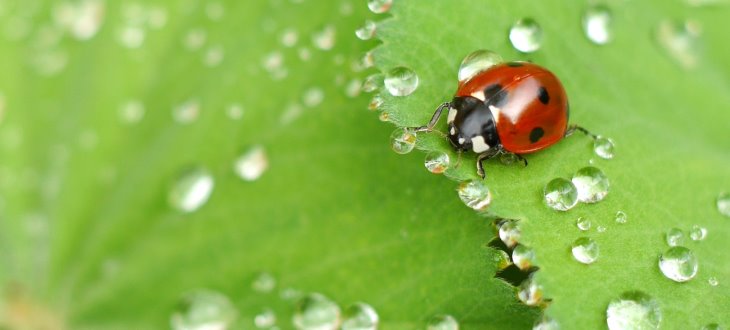The State We're In
Is an ‘Insect Armageddon’ happening here?
Most people don’t like insects except when they’re spectacularly beautiful, like monarch butterflies.
But insects are the Earth’s most numerous creatures, with a global estimate of 5.5 million species, including legions of little-known flies and beetles. Would anyone notice or care if these bugs started disappearing?
In 2017, somebody did notice. A group of European researchers studying insect abundance at nature reserves in Germany discovered that three-quarters of the flying insects in these protected places had disappeared since 1989.
Their alarming report made headlines around the world and raised serious questions: What’s causing this dramatic insect loss? Are insects also disappearing in places outside Germany, including the United States? What does severe insect decline mean for other species? How can this trend be reversed?
Dr. Hans de Kroon of Radboud University in the Netherlands, a lead scientist in the study, will address these questions at two New Jersey talks next week. Both are free and open to the public.
The first talk will be at Princeton University’s Guyot Hall at 12:30 p.m. Thursday, Nov. 21. The seminar is titled “On Biodiversity Mechanisms and a Biodiversity Crisis” and is sponsored by Princeton’s Department of Ecology & Evolutionary Biology.
The second will be held at 10 a.m. Saturday, Nov. 23, at Raritan Valley Community College in Branchburg. The talk is titled “Insect Armageddon: Where Have the Insects Gone, What Are the Causes of this Biodiversity Crisis, and How Can We Get Them Back?” The talk is sponsored by the college and the nonprofit Raritan Headwaters Association.
In addition to addressing the insect decline at German nature reserves, Dr. de Kroon will report on insect studies in other places and actions being taken by European government organizations, farmers, communities and individuals to help insects recover.
The groundbreaking German study was made possible by a trove of long-term data on insect numbers. Starting in 1989, researchers began collecting information at 63 nature reserves in Germany. Flying insects were collected in special traps and their total “biomass” was weighed. Every year for 27 years, same geographic locations and trap designs were used.
Comparing the data over nearly three decades, researchers discovered that flying insects had plunged by an average of 76 percent. And in the middle of summer, when insect numbers usually peak, the decline was even more severe at 82 percent.
“The flying insect community as a whole … has been decimated over the last few decades,” said the study by Radboud University and the Entomological Society Krefeld in Germany. “Loss of insect diversity and abundance is expected to provoke cascading effects on food webs and to jeopardize ecosystem services.”
Prior to the German study, it was already known that certain insects like butterflies and bees were declining in Western Europe and North America. The surprise in Germany was that all flying insect species, living in many habitat types within the nature reserves, had suffered massive losses.
The study noted that many of the German nature preserves were surrounded by agriculture, where pesticides and loss of wildflowers could impact insects. It concluded that insect declines could potentially be occurring in all areas of the world with high human disturbance.
Are similar insect declines happening in New Jersey? It’s hard to say definitively, because this state we’re in doesn’t have long-term data comparable to that in Germany. There are no studies of insects on preserved lands from 30 years ago to compare with today’s conditions.
But scientists and naturalists working in New Jersey have long believed, based on observations in the field, that insect abundance and variety have decreased in places affected by human disturbance.
“In the northeast United States, it is well known that diversity of insects is far lower in areas that are strongly influenced from man’s activities, such as urban areas and agricultural fields,” said Dr. Jon K. Gelhaus, professor at the Academy of Natural Sciences at Drexel University in Philadelphia. “When natural habitat is altered by non-native plants or destroyed by development, we see fewer types of insects than a comparable area that has a relatively intact natural habitat.”
Blaine Rothauser, a natural resource scientist for GZA GeoEnvironmental who conducts moth studies in New Jersey, also has noticed the relationship between land disturbance and insect abundance.
“Moth caterpillars are the foundation of the food web of migratory birds, and adults pollinate hundreds of species of plants,” said Blaine. “When we conduct a census of moths attracted to bright lights in rich, diverse, little-disturbed forests, we see great diversity and abundance. Often, there are 10 times more species than in fragmented forest patches, especially those over-browsed by deer, invaded by alien plants, and surrounded by chemically-treated fields.”
What is clear from the German study and the observations of New Jersey scientists is that insects deserve our attention and protection!
Insects pollinate plants – including food crops – and provide services like soil formation and biological pest control. They’re at the bottom of the wildlife food chain and are essential for the survival of birds, reptiles, amphibians, fish and mammals – and humans!
If you want to learn about the latest research and what you can do to help, be sure to attend one of Dr. de Kroon’s talks and check out these links:
To learn more about the German study, go to https://journals.plos.org/plosone/article?id=10.1371/journal.pone.0185809.
For a report on how neonicotinoid pesticides are affecting insects, go to www.iucn.org/news/secretariat/201709/severe-threats-biodiversity-neonicotinoid-pesticides-revealed-latest-scientific-review.
And to learn more about preserving New Jersey’s land and natural resources, visit the New Jersey Conservation Foundation website at www.njconservation.org or contact me at info@njconservation.org.
About the Authors
Alison Mitchell
Co-Executive Director
John S. Watson, Jr.
Co-Executive Director
Tom Gilbert
Co-Executive Director, 2022-2023
Michele S. Byers
Executive Director, 1999-2021
View their full bios here.
Filter
Get The Latest News
From The Garden State
In the
News

